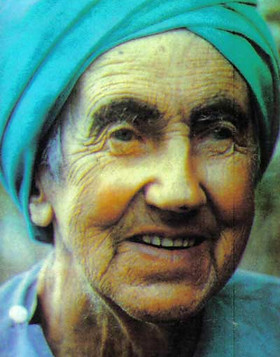Alfred Sorensen - Sunyata
“I am not alone — I am all-one.”

We are always aware, Sunyata!
Early years (Denmark → Europe)
Alfred Julius Emmanuel Sorensen was born October 27, 1890, near Aarhus, Denmark. He left school young and apprenticed as a gardener, working across France, Italy, and England.
In 1929 at Dartington Hall (Devon), he met Rabindranath Tagore, who invited him to Shantiniketan “to teach silence.” That encounter redirected his life toward India.
India becomes home (1930s–1970s)
Sorensen first toured India 1930–1933, then returned for good after 1933. Through Tagore he met the Nehru family; a friend offered him land above Almora at Crank’s Ridge (Kumaon), which became his base for decades. He lived simply as a sadhu, gardening and traveling to ashrams in winter.
During these years he encountered many teachers—Anandamayi Ma, Swami Ramdas, Baba Hari Dass, Neem Karoli Baba—yet he kept to an unadorned, solitary rhythm, writing compact notebooks in a playful idiom (“innerstanding,” “headucation”). He took Indian citizenship in 1953.
The Turning Point: The Gaze of the Sage
After leaving his native Denmark in his youth, Sorensen wandered the globe for years, working as a gardener in places like England and Italy. His spiritual search led him through various traditions, but he remained unfulfilled. In the 1930s, an inner pull brought him to India, and in 1936, he arrived at the ashram of Sri Ramana Maharshi in Tiruvannamalai.
Unlike others, he asked no questions and sought no instructions. He simply walked into the hall and sat in the silent presence of the sage. He later recounted that Ramana’s powerful, silent gaze "burnt away" the ego and quieted his mind in a way he had never experienced.
On his third visit (1940), seated quietly in the hall, he heard inwardly five words—“We are always aware, Sunyata!”—which he took as name, initiation, and mantra for the rest of his life.
For Sunyata, “emptiness” (śūnyatā) was not nihilism but alive, effortless awareness—a “full emptiness” in which nothing fundamental is missing or added.
A hillside hermitage
From his hut and little cave near Crank’s Ridge, Sunyata tended vegetables, received occasional visitors, and kept spare diaries that later became Sunyata: The Life & Sayings of a Rare-Born Mystic and Dancing with the Void.
To California with “nothing to sell” (1970s–1984)
After Alan Watts died (1973), members of the Alan Watts Society visited India, met Sunyata, and invited him to California precisely because he had “nothing to teach and nothing to sell.” He first stayed late 1974–early 1975, then relocated permanently in 1978. In the Bay Area he held gentle, conversation-style meetings on Alan Watts’s houseboat SS Vallejo in Sausalito.
What he pointed to (in plain words)
-
Ever-present awareness. The “five words” encapsulate his view: awareness is already here; no goal-seeking is required.
-
Full emptiness. Śūnyatā as creative openness—neither blankness nor belief, but ease in being.
-
No method, no persona. He declined the role of teacher or founder; the silence of being was the “teaching.”
-
Playful language. Word-seeds like innerstanding, headucation, all-one-ness nudge the mind toward quiet.
Try this (5–10 minutes)
-
“We are aware.” Sit comfortably; on the in-breath let “We are,” on the out-breath “aware” appear once. Nothing to improve—notice the noticing.
-
Affectionate detachment. Bring one sticky worry to mind; name it once, then rest attention in simple am-ness for three breaths. Repeat. (His notes favor gentle, effortless resting.)
Sunyata's path represents one of the most direct and unstructured expressions of Advaita Vedanta. Unlike traditions with detailed techniques or philosophical systems (like Integral Yoga or Tibetan Buddhism), his approach offers almost nothing for the conceptual mind to hold onto. For seekers who require structure, intermediate practices, or a defined framework, his radical call to "be nothing" can seem inaccessible. He represents an endpoint of the Jnana Yoga path—a final dissolving into the formless—which can be challenging for those accustomed to more affirmative, devotional, or methodical practices.
Further Exploration:
Beautiful story of his life told by a dear friend of his:
Audio Book of his biography:
https://www.youtube.com/watch?v=uImRVJzxjwU&list=PLftHRnuuQRygivSyS2aJ96rCHcxKxywQB&ab_channel=MysticScribe
Nectar of Sunyata - pdf of his book:
https://www.holybooks.com/wp-content/uploads/Nectar-of-Sunyata.pdf